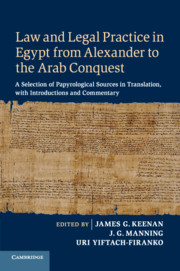Refine search
Actions for selected content:
23990 results in Ancient history
Three - Religion and Society in the Middle Helladic Period
-
- Book:
- Religion and Society in Middle Bronze Age Greece
- Published online:
- 05 June 2014
- Print publication:
- 12 May 2014, pp 72-129
-
- Chapter
- Export citation
Religion and Society in Middle Bronze Age Greece - Half title page
-
- Book:
- Religion and Society in Middle Bronze Age Greece
- Published online:
- 05 June 2014
- Print publication:
- 12 May 2014, pp i-ii
-
- Chapter
- Export citation
Acknowledgments
-
-
- Book:
- Religion and Society in Middle Bronze Age Greece
- Published online:
- 05 June 2014
- Print publication:
- 12 May 2014, pp xiii-xiv
-
- Chapter
- Export citation
Five - Religion and Society in the Late Helladic I Period
-
- Book:
- Religion and Society in Middle Bronze Age Greece
- Published online:
- 05 June 2014
- Print publication:
- 12 May 2014, pp 147-206
-
- Chapter
- Export citation
Two - The Formation of the Middle Helladic Period
-
- Book:
- Religion and Society in Middle Bronze Age Greece
- Published online:
- 05 June 2014
- Print publication:
- 12 May 2014, pp 38-71
-
- Chapter
- Export citation
One - Introduction
-
- Book:
- Religion and Society in Middle Bronze Age Greece
- Published online:
- 05 June 2014
- Print publication:
- 12 May 2014, pp 1-37
-
- Chapter
- Export citation
Religion and Society in Middle Bronze Age Greece - Title page
-
-
- Book:
- Religion and Society in Middle Bronze Age Greece
- Published online:
- 05 June 2014
- Print publication:
- 12 May 2014, pp iii-iii
-
- Chapter
- Export citation
Illustrations
-
- Book:
- Religion and Society in Middle Bronze Age Greece
- Published online:
- 05 June 2014
- Print publication:
- 12 May 2014, pp vii-viii
-
- Chapter
- Export citation
Appendix - Catalogue of Middle Helladic and Early Mycenaean Tumuli
-
- Book:
- Religion and Society in Middle Bronze Age Greece
- Published online:
- 05 June 2014
- Print publication:
- 12 May 2014, pp 211-256
-
- Chapter
- Export citation
Tables
-
- Book:
- Religion and Society in Middle Bronze Age Greece
- Published online:
- 05 June 2014
- Print publication:
- 12 May 2014, pp xi-xii
-
- Chapter
- Export citation

Law and Legal Practice in Egypt from Alexander to the Arab Conquest
- A Selection of Papyrological Sources in Translation, with Introductions and Commentary
-
- Published online:
- 05 May 2014
- Print publication:
- 24 April 2014
Chapter 1 - Introduction and historical framework
-
-
- Book:
- Law and Legal Practice in Egypt from Alexander to the Arab Conquest
- Published online:
- 05 May 2014
- Print publication:
- 24 April 2014, pp 1-30
-
- Chapter
-
- You have access
- Export citation
References
-
- Book:
- The Ancient Jews from Alexander to Muhammad
- Published online:
- 05 June 2014
- Print publication:
- 24 April 2014, pp 163-182
-
- Chapter
- Export citation
Maps
-
- Book:
- Law and Legal Practice in Egypt from Alexander to the Arab Conquest
- Published online:
- 05 May 2014
- Print publication:
- 24 April 2014, pp xxviii-xxx
-
- Chapter
- Export citation
Preface
-
- Book:
- The Ancient Jews from Alexander to Muhammad
- Published online:
- 05 June 2014
- Print publication:
- 24 April 2014, pp ix-ix
-
- Chapter
- Export citation
Dedication
-
- Book:
- Law and Legal Practice in Egypt from Alexander to the Arab Conquest
- Published online:
- 05 May 2014
- Print publication:
- 24 April 2014, pp v-vi
-
- Chapter
- Export citation
Suggested reading for introductions to papyrology in English
-
- Book:
- Law and Legal Practice in Egypt from Alexander to the Arab Conquest
- Published online:
- 05 May 2014
- Print publication:
- 24 April 2014, pp 552-552
-
- Chapter
- Export citation
Index
-
- Book:
- The Ancient Jews from Alexander to Muhammad
- Published online:
- 05 June 2014
- Print publication:
- 24 April 2014, pp 183-190
-
- Chapter
- Export citation
6 - Jews under Christian rule
-
- Book:
- The Ancient Jews from Alexander to Muhammad
- Published online:
- 05 June 2014
- Print publication:
- 24 April 2014, pp 124-151
-
- Chapter
- Export citation
Chapter 5 - Capital
-
-
- Book:
- Law and Legal Practice in Egypt from Alexander to the Arab Conquest
- Published online:
- 05 May 2014
- Print publication:
- 24 April 2014, pp 226-275
-
- Chapter
- Export citation
